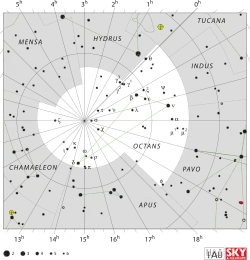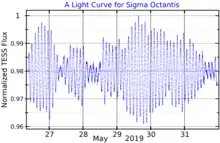 | |
| Observation data Epoch J2000.0 Equinox J2000.0 (ICRS) | |
|---|---|
| Constellation | Octans |
| Right ascension | 21h 08m 46.86357s[1] |
| Declination | −88° 57′ 23.3983″[1] |
| Apparent magnitude (V) | 5.47[2] |
| Characteristics | |
| Spectral type | F0 IV[3] |
| U−B color index | +0.13[2] |
| B−V color index | +0.26[2] |
| Variable type | δ Sct[4] |
| Astrometry | |
| Radial velocity (Rv) | +11.9[5] km/s |
| Proper motion (μ) | RA: +26.323[1] mas/yr Dec.: +4.721[1] mas/yr |
| Parallax (π) | 11.1005 ± 0.0616 mas[1] |
| Distance | 294 ± 2 ly (90.1 ± 0.5 pc) |
| Absolute magnitude (MV) | 0.86±0.09[6] |
| Details | |
| Mass | 1.59[7] M☉ |
| Radius | 4.4[1] R☉ |
| Luminosity | 44[1] L☉ |
| Surface gravity (log g) | 3.71[7] cgs |
| Temperature | 7,415±252[7] K |
| Metallicity [Fe/H] | −0.5[1] dex |
| Rotational velocity (v sin i) | 145[4] km/s |
| Age | 912[7] Myr |
| Other designations | |
| Database references | |
| SIMBAD | data |
Sigma Octantis is a solitary[9] star in the Octans constellation that forms the pole star of the Southern Hemisphere. Its name is also written as σ Octantis, abbreviated as Sigma Oct or σ Oct, and it is officially named Polaris Australis (/poʊˈlɛərɪs ɔːˈstreɪlɪs/).[10] The star is positioned one degree away from the southern celestial pole of the Southern Hemisphere, lying in nearly opposite direction to the North Star on the celestial sphere.
Located approximately 294 light-years from Earth, it is classified as a subgiant with a spectral type of F0 III. Sigma Octantis has an apparent magnitude of 5.5, but is slightly variable and is classified as a Delta Scuti variable.
Nomenclature

σ Octantis (Latinised to Sigma Octantis) is the star's Bayer designation.
As the southern hemisphere's pole star it bore the name Polaris Australis, first applied in the 1700s.[12] In 2016, the IAU organized a Working Group on Star Names (WGSN)[13] to catalog and standardize proper names for stars. The WGSN approved the name Polaris Australis for this star on 5 September 2017 and it is now so included in the List of IAU-approved Star Names.[10] It is the southernmost named star.
Properties
With a spectral class of F0IV,[3] Sigma Octantis appears to be a subgiant, although it has also been classified as F0III.[14] Evolutionary models place it at the very end of its main sequence life with an age of about 900 million years.[1][7] It has expanded somewhat to a size 4.4 that of the Sun and emits 44 times as much electromagnetic radiation from its photosphere at an effective temperature of 7,415 K.
Sigma Octantis is a Delta Scuti variable, varying by about 0.03 magnitudes every 2.33 hours.[4] It is thought to pulsate only in the fundamental mode.[15]
Southern pole star
Sigma Octantis is the current southern pole star, whose counterpart is Polaris, the current North Star. To an observer in the southern hemisphere, Sigma Octantis appears almost motionless and all the other stars in the Southern sky appear to rotate around it. It is part of a small "half hexagon" shape. It is slightly more than a degree away from the true south pole, and the south celestial pole is moving away from it due to precession of the equinoxes.
At magnitude +5.42, Sigma Octantis is barely visible to the naked eye, making it unusable for navigation, especially by comparison with the much brighter and more easily visible Polaris.[16] Because of this, the constellation Crux is often preferred for determining the position of the South Celestial Pole.[17] Once Sigma Octantis' approximate position has been determined, either by the major stars in Octans or using the Southern Cross (Crux) method, it can be positively verified using an asterism: Sigma, Chi, Tau, and Upsilon Octantis are all stars of around magnitude 5.6, and form the distinctive shape of a trapezoid.
In astrometrics
Sigma Octantis was used as a reference to measure the magnitudes of stars in the southern hemisphere for the 1908 Revised Harvard Photometry catalogue. The Pole Star and Lambda Ursae Minoris were used for the northern hemisphere. It was then noted that "Neither of these stars appears to vary perceptibly" but that, due to the procedures used "if they did, the variation would have no effect on the final measures."[18]
In culture
Sigma Octantis is the dimmest star to be represented on a national flag. It appears on the flag of Brazil, symbolising the Brazilian Federal District.[19]
See also
References
- 1 2 3 4 5 6 7 8 9 Vallenari, A.; et al. (Gaia collaboration) (2023). "Gaia Data Release 3. Summary of the content and survey properties". Astronomy and Astrophysics. 674: A1. arXiv:2208.00211. Bibcode:2023A&A...674A...1G. doi:10.1051/0004-6361/202243940. S2CID 244398875. Gaia DR3 record for this source at VizieR.
- 1 2 3 Johnson, H. L.; et al. (1966). "UBVRIJKL photometry of the bright stars". Communications of the Lunar and Planetary Laboratory. 4 (99): 99. Bibcode:1966CoLPL...4...99J.
- 1 2 Houk, Nancy (1975). "Michigan catalogue of two-dimensional spectral types for the HD stars". University of Michigan Catalogue of Two-Dimensional Spectral Types for the Hd Stars. Volume I. Declinations -90_ to -53_Ƒ0. Ann Arbor, Michigan: Dept. of Astronomy, University of Michigan. 1. Bibcode:1975mcts.book.....H.
- 1 2 3 Rodríguez, E.; et al. (June 2000). "A revised catalogue of δ Sct stars". Astronomy and Astrophysics Supplement. 144 (3): 469–474. Bibcode:2000A&AS..144..469R. doi:10.1051/aas:2000221. hdl:10261/226673.
- ↑ Wilson, Ralph Elmer (1953). "General catalogue of stellar radial velocities". Washington. Carnegie Institution of Washington: 0. Bibcode:1953GCRV..C......0W.
- ↑ Antonello, E.; Mantegazza, L. (November 1997). "Luminosity and related parameters of δ Scuti stars from HIPPARCOS parallaxes. General properties of luminosity". Astronomy and Astrophysics. 327: 240–244. Bibcode:1997A&A...327..240A.
- 1 2 3 4 5 David, Trevor J.; Hillenbrand, Lynne A. (2015). "The Ages of Early-Type Stars: Strömgren Photometric Methods Calibrated, Validated, Tested, and Applied to Hosts and Prospective Hosts of Directly Imaged Exoplanets". The Astrophysical Journal. 804 (2): 146. arXiv:1501.03154. Bibcode:2015ApJ...804..146D. doi:10.1088/0004-637X/804/2/146. S2CID 33401607.
- ↑ "sig Oct". SIMBAD. Centre de données astronomiques de Strasbourg. Retrieved 2017-08-10.
- ↑ Eggleton, P. P.; Tokovinin, A. A. (September 2008). "A catalogue of multiplicity among bright stellar systems". Monthly Notices of the Royal Astronomical Society. 389 (2): 869–879. arXiv:0806.2878. Bibcode:2008MNRAS.389..869E. doi:10.1111/j.1365-2966.2008.13596.x. S2CID 14878976.
- 1 2 "Naming Stars". IAU.org. Retrieved 16 December 2017.
- ↑ "MAST: Barbara A. Mikulski Archive for Space Telescopes". Space Telescope Science Institute. Retrieved 8 December 2021.
- ↑ Kaler, James B. (2006). The Hundred Greatest Stars. Springer Science & Business Media. p. 171. ISBN 0387216251.
- ↑ "IAU Working Group on Star Names (WGSN)". Retrieved 22 May 2016.
- ↑ Malaroda, S. (August 1975), "Study of the F-type stars. I. MK spectral types", Astronomical Journal, 80: 637–641, Bibcode:1975AJ.....80..637M, doi:10.1086/111786.
- ↑ Tsvetkov, Ts. G. (1982). "On the Radial Pulsations of the delta Scuti Stars sigma Octantis and B Octantis". Information Bulletin on Variable Stars. 2084: 1. Bibcode:1982IBVS.2084....1T.
- ↑ "Sigma Octantis". Jumk.De. 26 July 2013. Retrieved 26 July 2013.
- ↑ "Finding South". CSIRO. 26 July 2013. Archived from the original on 14 August 2013. Retrieved 26 July 2013.
- ↑ Pickering, Edward Charles (1908). "Revised Harvard Photometry". Annals of the Astronomical Observatory of Harvard College. 50: 2. Bibcode:1908AnHar..50....1P.
- ↑ "Astronomy of the Brazilian Flag". FOTW Flags Of The World website.